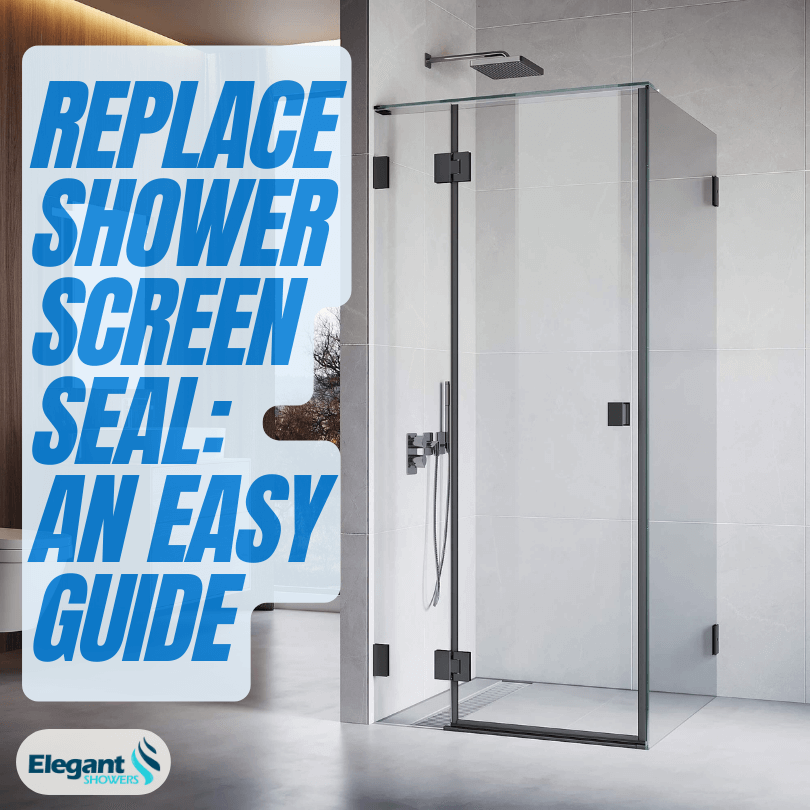Shower screens provide a watertight divider, keeping water safely inside tub areas upon bathing. Rubber or vinyl seals running their interior perimeter maintain leak protection over years of constant use. But these compressible barrier materials gradually wear down with exposure to hot water, humidity, and daily closing pressures between screen doors and jambs. Knowing when and how to replace worn seals restores a fully watertight function for improved showering experiences in the long term.
What is a Shower Screen Seal?
Shower screen seals occupy a simple yet crucial role in keeping water from escaping under door panels or around glass sides into surrounding bathroom spaces.
Typically made of long-lasting chloroprene rubber, these vertically installed compressible strips line metal, glass, or plastic framed shower box inside edges interfacing against doors or stationary panels using compression fitments.
High temperature, chemical, and weathering resistance provide years of reliable shower barrier service. However, consistent compression cycles between doors gradually degrade adhesive bonds over time.
How Often to Replace a Shower Screen Seal
On average, shower screen seals warrant replacing every 3-5 years, depending on usage levels and water quality. More frequent replacement cycles down to every 1-2 years for chlorinated pools or spas with frames swinging daily.
Any visible cracking, stretching, or jamb leak evidence flags nearer-term inspection needs. Planning seal replacements during routine maintenance taps or tile caulking refreshers makes it convenient to renew while equipment is onsite. Especially in rental units, staying ahead of any seal wear protects frames from water damage.
Signs that You Should Replace a Shower Screen Seal
Sign 1: Visible Wear and Tear
Look for obvious surface abrasions, cuts, and dried-out or cracked sections, allowing water to weep when doors close. If missing chunks or holes manifest, new seals prove necessary before leaks risk dripping inside walls.
Sign 2: Water Leakage
Pools collecting on floor corners near frames or soaked jamb screws indicate age-related seal failures regardless of other visible wear levels letting water escape the enclosure. Any observed leakage warrants replacing seals.
Sign 3: Mold or Mildew Growth
Consistent condensation or escaped shower water accumulating in frame joints feeding mold growth makes deteriorated seals highly probable despite limited visible flaws. Eliminating leaks prevents this health hazard.
Sign 4: Difficulty in Closing Shower Doors
If doors or panels show sudden resistance when properly latching or exhibit looseness, allowing wider gaps, compressed seals likely reach the end of effectiveness and are unable to sustain consistent pressure between surfaces.
How to Replace a Shower Screen Seal?
Replacing worn shower screen seals before leaks form prevents permanent water damage. Carefully follow these basic steps:
- Measure Existing Seals: Measure current seal lengths with a tape measure around the entire perimeter of shower screen frames where fresh pieces will adhere, including bottom tracks. Note any mitered corner fineness requiring replication.
- Purchase Replacement Seal: Obtain replacement vinyl or rubber seal strips about one-quarter inch wider than framing depths to sustain compression from quality home improvement retailers. For custom shower shapes, choose seal types that are easily manipulated onsite, like foam tapes versus rigid rubber.
- Remove the Old Seal: Starting in corners, carefully pry up spent seals using thin putty knives to get lift edges exposed. Gently heat stubborn sections with a hair dryer if bonded considerably. Slowly peel entire pieces off, fully preparing a clean base.
- Clean the Installation Area: Scrub all residual adhesive or seal fragments off frame channels and door jambs so new materials adhere properly. Acetone or rubbing alcohol assists in cleaning any oily residue. Let dry fully.
- Cut New Seals to Size: Benchmark against removed pieces, and cut replacement vinyl or rubber seals to identical lengths using sharp razors against metal straightedges for smooth custom miters suiting the framed opening. Reuse good-conditioned original corner pieces if possible.
- Install Fresh Seals: Test fitted, trimmed replacement seals can now be easily pressed into clean openings by hand using firm even pressure ensuring uniform adhesion from frame bottom tracks up each junction. Visually inspect for any slight gaps popping up afterward under compression, indicating potential correction needs.
- Test Fitment and Watertightness: Close doors and panels firmly, listening, looking, and feeling for subtle leaks noticeable around fresh seals. Fine-tune placements using razor trims if minor edge seepage points appear before water spray testing shower enclosure integrity completely.
Final Words
While essential shower screen door seals endure impressive wear over time, keeping interiors dry and recognizing when replacement becomes necessary prevents irreversible leaks or damage. Seeking leading indicator clues like worn surfaces, pooling thresholds, or newfound closing resistance allows quick, proactive seal replacements, restoring full barrier functionality for years ahead.
Following basic measuring, trimming, and installation steps makes refreshing seals an easy weekend upgrade project, delivering an outsized return on investment through ongoing leak prevention peace of mind.
FAQs
What seal materials work best in shower screens?
Chloroprene rubber makes very durable, high-performance shower seals resisting heat, chemicals, and compression wear well over the years. Premium grade vinyls also suit most shower frame applications at lower price points but may need replacing more often.
How can I make shower screen seals last longer?
Avoid excessive framed screen opening/closing force, which strains seals over time. Lubricate rubber gaskets with silicone spray annually. Limit chemical cleaner exposure to corroding surfaces. Check and reseat popped-out sections promptly.
When replacing just seals, could underlying frame leaks exist?
If brand new seals still prove unable to eliminate water seeping outside enclosure frames, inspect for hairline cracks or loose fastener points, allowing leaks unrelated to seal integrity itself first before assuming faulty materials.
Can I reduce measurement mistakes when buying new seals?
Carefully noting current seal lengths during removal aids in precision replacement purchasing. For custom showers, temporarily taping new foam seals in place allows exact templates for cutting to avoid return trips to stores after sizing mistakes.
How soon can I shower after changing the seals?
Quality seal adhesives cure fully in 24-48 hours before tolerating hot steam and soaking conditions. Review product instructions to confirm adequate drying times, ensuring bonds are optimized before reintroducing water pressure spraying directly on fresh seals daily.
What tools will I need to replace a shower screen seal?
Typically, you need a measuring tape, scissors, or a sharp knife to cut the seal to length and a flat-head screwdriver to help remove the old seal if it's stubborn. No special tools are usually required.
Where can I buy a replacement shower screen seal?
Replacement seals are available at hardware stores, plumbing supplies stores, or online retailers. Ensure you have the correct measurements and understand the profile type of your existing seal to purchase the right replacement.
How do I prevent my new shower screen seal from wearing out quickly?
Regular cleaning and maintenance can extend the life of your shower screen seal. Avoid using harsh chemicals that can degrade the seal material and wipe down the seal after each use to prevent mold and mildew buildup.
Can I cut the shower screen seal to fit if it’s too long?
Yes, if the replacement seal is too long, you can cut it down to the correct size using scissors or a sharp knife. Ensure the cut is straight and clean for the best fit.
What should I do if the new seal doesn't stop the water leaks?
If water continues to leak after installing the new seal, ensure that the seal is correctly positioned and fully pressed against the glass and the shower base or side. If leaks persist, double-check the seal type and size to ensure it matches your shower screen’s specifications.
How long does it take to replace a shower screen seal?
The process can typically be completed within 30 minutes to an hour, depending on your proficiency and whether any cleaning is required. It's a quick fix that can lead to significant improvements in your bathroom's functionality.






